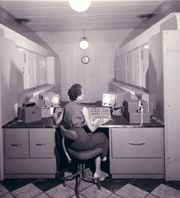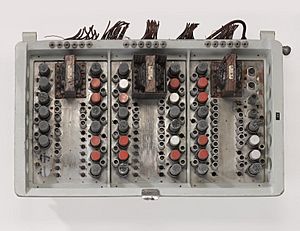Ferranti Mark 1 facts for kids

Ferranti Mark 1, c. 1951
|
|
| Also known as | Manchester Electronic Computer Manchester Ferranti |
|---|---|
| Product family | Manchester computers |
| Predecessor | Manchester Mark 1 |
The Ferranti Mark 1 was a very important computer. It was the world's first computer that people could buy! This amazing machine was built by a British company called Ferranti Ltd. It was a "general-purpose" computer, meaning it could do many different kinds of tasks. It was also a "stored program" computer, which means it could keep its instructions inside its memory.
Even though some other computers like the BINAC and Z4 existed, the Ferranti Mark 1 was special. The Z4 was mechanical and couldn't be easily reprogrammed. The BINAC didn't work well after it was delivered. The first Ferranti Mark 1 was given to the Victoria University of Manchester in February 1951. This was even before the famous UNIVAC I computer was delivered in the USA!
Contents
How the Ferranti Mark 1 Worked
The Ferranti Mark 1 was based on an earlier computer called the Manchester Mark 1. That machine was designed by Freddie Williams and Tom Kilburn at the University of Manchester. Ferranti improved it by making its memory bigger and faster. They also added more instructions for the computer to follow.
The Mark 1 used special glass tubes called Williams tubes for its main memory. Each tube stored information as tiny dots of electricity. The computer also had a much larger "secondary storage" system. This was a magnetic drum that could hold a lot more information. Imagine it like a giant spinning hard drive!
This computer used about 4,050 vacuum tubes. These tubes were like old-fashioned light bulbs that helped the computer do its calculations. It had about 50 different instructions it could follow. A basic step took about 1.2 milliseconds. This was very fast for its time!
To program the Mark 1, people had to use a special code. They would punch holes into paper tape to give the computer instructions. The characters used for programming looked a bit random, like /E@A:SIU½DRJNFCKTZLWHYPQOBG"MXV£. This made it tricky to learn!
The first Mark 1 went to the University of Manchester. Ferranti hoped to sell many more. They even got an order from the Atomic Energy Research Establishment. But that order was cancelled. Luckily, the University of Toronto bought that computer for a very low price. They named it FERUT. This computer was used for many important tasks, like helping to build the St. Lawrence Seaway.
The Improved Mark 1 Star
After the first two computers, Ferranti made an improved version. It was called the Ferranti Mark 1 Star or Mark 1*. The main goal was to make the computer easier to use and program.
One big change was how the computer read the paper tape. The new machines used a much simpler code, like ø£½0@:$ABCDEFGHIJKLMNPQRSTUVWXYZ. This made programming much less confusing. They also fixed some tricky parts of the computer's instructions. This made it easier for programmers to avoid mistakes.
The Mark 1/1* was a very heavy machine, weighing about 10,000 pounds!
At least seven Mark 1* computers were delivered between 1953 and 1957. One went to Shell labs in Amsterdam. Another was installed at Avro, a company that built aircraft. This computer helped them design planes like the Avro Vulcan.
Did you know that the parents of Tim Berners-Lee worked on these computers? Tim Berners-Lee invented the World Wide Web! His parents, Conway Berners-Lee and Mary Lee Woods, both worked on the Ferranti Mark 1 and Mark 1*.
Computer Music
The Ferranti Mark 1 had a special instruction called "hoot." This command allowed the computer to make sounds! You could even change the pitch of the sound.
This feature was used to create some of the earliest computer-generated music. In late 1951, the BBC recorded the Mark 1 playing a medley of songs. These included "God Save the King", "Baa Baa Black Sheep", and "In the Mood". A mathematics teacher named Christopher Strachey programmed the music.
However, the Ferranti Mark 1 was not the very first computer to play music. The CSIRAC, an Australian computer, played "Colonel Bogey" before it.
Computer Games
In November 1951, a scientist named Dr. Dietrich Prinz created one of the first computer games. It was a chess-playing program for the Manchester Ferranti Mark 1 computer.
The Mark 1 wasn't powerful enough to play a full game of chess. So, Prinz's program could only solve "mate-in-two" chess problems. This means it would find a way for White to checkmate Black in just two moves. The program would check thousands of possible moves. It usually took about 15 to 20 minutes to find a solution!
The game had some limitations. For example, it couldn't do castling or pawn promotion. But it was still an amazing achievement for its time!
See also
- History of computing hardware
- List of vacuum-tube computers
- Manchester computers
Images for kids



